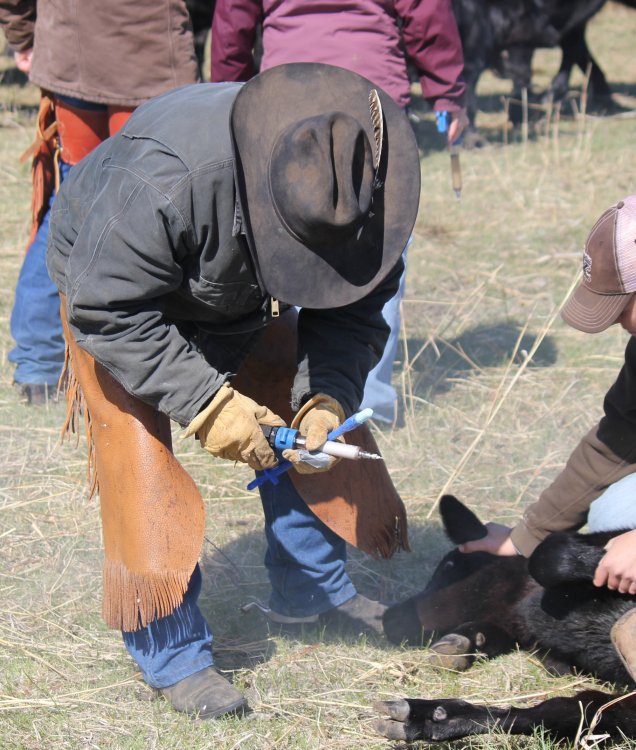
By Rob Eirich, Nebraska Beef Quality Assurance, Nebraska Extension
Calving season for many producers is near, which means it is time to develop a Herd Health Plan (HHP) to start those newborn calves out on the right track, promoting good health. An appropriate Herd Health Plan/Protocol ensures that all cattle are raised in the best health.
A strong HHP begins with a yearly production calendar that includes cattle nutrition, reproduction management, vaccination schedules, and marketing - all of which are critical to sustainable beef cattle production. Management practices can be better matched with cattle needs by looking at the annual production cycle month-by-month.
The University of Nebraska-Lincoln Animal Science Department has an example of a beef production calendar at http://beef.unl.edu.
Once a production calendar is developed, a producer can work with his or her veterinarian to plan a specific preventative health program for their herd. The veterinarian can help a beef operation best tailor health management to deal with local diseases, parasites, and other regional health issues.
Specifically for young calves (Birth to three months), the core vaccination program should include: 4 way IBR, BVD, PI3, BRSV; 2 way Pasteurella; and 4/7 way Clostridial. There are additional considerations, such as fly control and implanting, that producers should discuss with their veterinarian to best meet the herd needs and goals. Depending on labor and timing, developing a strong plan can improve effectiveness and economics for the operation. Additional planning and consideration is needed when developing a preconditioning program two to four weeks prior to weaning, for more information read the UNL NebGuide G2248 “Economic Considerations for Preconditioning Calves for Feedlots” (http://go.unl.edu/hydc).
In addition to vaccination of young calves, producers need to develop plans for good management practices for castration, dehorning, and branding (if applicable). Beef Quality Assurance (BQA) in a collaborative effort with veterinarians, animal scientists, cattle industry leaders, production managers, and producers have put forward a consensus opinion for achieving optimal outcomes. The following guidelines are not intended to be exclusive of any one specific technique over another, but are focused on the animal and are aimed to satisfy scientifically valid and feasible approaches to meeting cattle health and welfare.
Castration of beef cattle is performed to reduce inter-animal aggression and injuries, improve human safety, and avoid the risk of unwanted pregnancies in the herd. Where practical, cattle should be castrated before the age of three months, or at the first available handling opportunity beyond that age. The use of method(s) that promote the well-being and comfort of cattle should be encouraged. It is recommended that all animals not used for breeding purposes be castrated and allowed to heal before leaving the operation of origin. Consult your veterinarian for procedures/methods that are most appropriate for your herd.
Dehorning of naturally horned cattle is common to reduce animal injuries and for human safety. Cattle should be dehorned while horn development is still at the horn bud stage, or at the first available handling opportunity. This is because the procedure involves less tissue trauma at that age. Methods of dehorning include removal of the horn buds with a knife or dehorning spoon, thermal cautery of the horn buds, or application of chemical paste to cauterize the horn buds. Producers should seek veterinarian’s guidance when developing plans and selecting procedures.
Branding of calves may be the only practical method of permanent identification or requirement of ownership. If calves are hot iron or freeze branded, it should be accomplished quickly, expertly, and with the proper equipment. BQA guidelines recommend branding on the hip area and never on the face or jaw.
Lastly, remember to follow all product labels pertaining to dosage, administration, storage, and withdrawal times, and to keep good health records.
Calving time can be busy, stressful, and labor intensive, by developing a HHP your operation will be prepared to start your young calves off to a healthy, safe, and productive life. In addition to the care and well-being of your herd, BQA Guidelines are also developed with the health and safety of the producers and employees who handle these animals in mind.
For more information about Nebraska Beef Quality Assurance or to get BQA certified, visit bqa.unl.edu or contact Rob Eirich, Nebraska Extension Educator and Director of BQA at the UNL Panhandle Research and Extension Center 308-632-1230 or reirich2@unl.edu .
Beef Quality Assurance is a nationally coordinated, state implemented program that provides systematic information to U.S. beef producers and beef consumers of how common sense husbandry techniques can be coupled with accepted scientific knowledge to raise cattle under optimum management and environmental conditions. Eirich directs the program in the state of Nebraska, in a partnership between Nebraska Extension, Nebraska Cattlemen, and the Nebraska Beef Council.